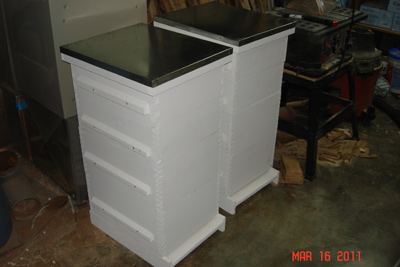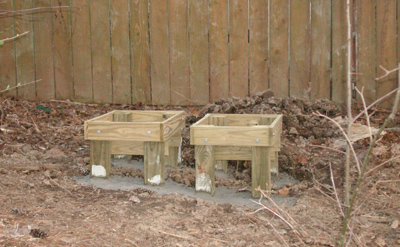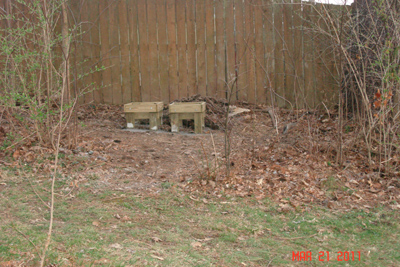Where I Placed my Backyard Bee Hives
This year I'll be placing two hives in our backyard. Placing hives is easy if you have acres of woods, fields and farmland available, but can a little more tricky to place them in your own backyard.
Where to place these hives was a fairly simple decision for me based on how my backyard is designed, but in case it's not an easy one for you, let me give you some tips.
Safety
It's important to locate your hives in a place that's not a disturbance to other animals, pets, neighbors, etc. If the hive is going to be close to your neighbors, a driveway or pathway for pedestrians, it's important to construct a fence or plant bushes in front of the hives, which will cause the bees to fly out and up above pedestrian's heads and not bother them.
Convenient access
When thinking about where to locate your hives, it's a good idea to place them somewhere you can drive up to. When carrying full deep hive bodies (up to 90 pounds!), or equipment, sugar syrup, etc. any long distance can become really hard work!
Avoid Low Lying Areas
Areas at the bottom of a valley, between two ravines or along a low lying creek is probably not the most ideal area for hives. These low lying areas are prone to fog, mist, and cold air which could encourage mold and health problems for the bees.
Sheltered from Strong Winds
When placing hives near the top of a hill, first check to ensure that there are plenty of trees, shrubs, etc. that can serve as a wind break. Tops of hills usually have strong wind gusts, and a storm or even strong wind gust could blow the top of the hive off, or worse.
Place them Level
It can be a good idea to place your hives so that they tip forward a few degrees. This is particularly handy so that rainwater that gets blown in on the landing board during heavy rain can drain back out.
This is especially true for solid bottom boards, screen bottom boards don't have such an issue as the rain will fall through the screen.
You do, however, want to make sure your hive is level from left to right. The bees will build comb straight down, plumb level. That is to say, if you place your hive leaning to one side, they will build the comb off the edge of the frame, straight towards the ground, ignoring that their provided frames are leaning to one side.
I recently finished building two hives, and was ready to find a permanent place for them.

Using some treated 2x2s and 2x4s we constructed some hive stands that would provide years of use. The stands will allow either solid bottom boards, or screen bottom boards (like I made for my hives).
My backyard has a slight slope to it, so I wanted to place them at the top of the yard. It also has a 6 foot wooden fence there and would provide great windbreak and help to keep them out of sight.

Stepping back farther from the stands, you can see there is quite a bit of brush, saplings, and just out of sight is several larger trees. This should help the bees come out of the hives, fly high up into the air, and not in the path of people.

You'll notice I placed them fairly close together. I've read that migratory beekeepers (who move their hives to fields of trees for the purpose of pollinating the fields) often load their hives on pallets. They load them 4 to a pallet, side by side, back to back and they never take them off the pallet.
I've read that drifting bees (going into a neighboring hive by accident) is fairly negligent, and the other hive is not hostile towards them.

With fairly limited space, due to the larger trees you can't see to the left and right, I decided to place them close enough together so that I had room to work on each side, behind them and still have room to set equipment down.
I decided to add a bit of concrete to the hive stand legs, just in case of large animals or strong storms come through the area, and the fence and trees somehow don't help break the wind.
I also left the stands tilt forward 1 or 2 degrees in case I ever switch to solid bottom boards. I was very careful to level them exactly level from left-to-right so the bees will build the comb straight and even.
We'll see if they like their new home when they arrive at the end of April!
Where to place these hives was a fairly simple decision for me based on how my backyard is designed, but in case it's not an easy one for you, let me give you some tips.
Safety
It's important to locate your hives in a place that's not a disturbance to other animals, pets, neighbors, etc. If the hive is going to be close to your neighbors, a driveway or pathway for pedestrians, it's important to construct a fence or plant bushes in front of the hives, which will cause the bees to fly out and up above pedestrian's heads and not bother them.
Convenient access
When thinking about where to locate your hives, it's a good idea to place them somewhere you can drive up to. When carrying full deep hive bodies (up to 90 pounds!), or equipment, sugar syrup, etc. any long distance can become really hard work!
Avoid Low Lying Areas
Areas at the bottom of a valley, between two ravines or along a low lying creek is probably not the most ideal area for hives. These low lying areas are prone to fog, mist, and cold air which could encourage mold and health problems for the bees.
Sheltered from Strong Winds
When placing hives near the top of a hill, first check to ensure that there are plenty of trees, shrubs, etc. that can serve as a wind break. Tops of hills usually have strong wind gusts, and a storm or even strong wind gust could blow the top of the hive off, or worse.
Place them Level
It can be a good idea to place your hives so that they tip forward a few degrees. This is particularly handy so that rainwater that gets blown in on the landing board during heavy rain can drain back out.
This is especially true for solid bottom boards, screen bottom boards don't have such an issue as the rain will fall through the screen.
You do, however, want to make sure your hive is level from left to right. The bees will build comb straight down, plumb level. That is to say, if you place your hive leaning to one side, they will build the comb off the edge of the frame, straight towards the ground, ignoring that their provided frames are leaning to one side.
I recently finished building two hives, and was ready to find a permanent place for them.

Using some treated 2x2s and 2x4s we constructed some hive stands that would provide years of use. The stands will allow either solid bottom boards, or screen bottom boards (like I made for my hives).
My backyard has a slight slope to it, so I wanted to place them at the top of the yard. It also has a 6 foot wooden fence there and would provide great windbreak and help to keep them out of sight.

Stepping back farther from the stands, you can see there is quite a bit of brush, saplings, and just out of sight is several larger trees. This should help the bees come out of the hives, fly high up into the air, and not in the path of people.

You'll notice I placed them fairly close together. I've read that migratory beekeepers (who move their hives to fields of trees for the purpose of pollinating the fields) often load their hives on pallets. They load them 4 to a pallet, side by side, back to back and they never take them off the pallet.
I've read that drifting bees (going into a neighboring hive by accident) is fairly negligent, and the other hive is not hostile towards them.

With fairly limited space, due to the larger trees you can't see to the left and right, I decided to place them close enough together so that I had room to work on each side, behind them and still have room to set equipment down.
I decided to add a bit of concrete to the hive stand legs, just in case of large animals or strong storms come through the area, and the fence and trees somehow don't help break the wind.
I also left the stands tilt forward 1 or 2 degrees in case I ever switch to solid bottom boards. I was very careful to level them exactly level from left-to-right so the bees will build the comb straight and even.
We'll see if they like their new home when they arrive at the end of April!
Comments For This Post: (2) | Post Your Comments! Hide The Comment Form